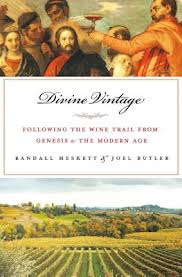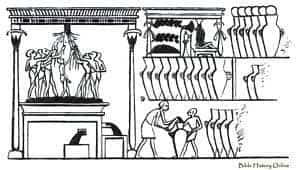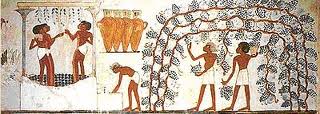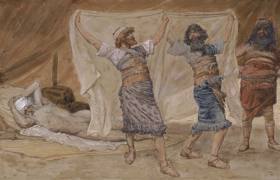 Today’s post is an interview is with Randall Heskett, co-author of Divine Vintage: Following the Wine Trail from Genesis to the Modern Age
Today’s post is an interview is with Randall Heskett, co-author of Divine Vintage: Following the Wine Trail from Genesis to the Modern Age. Heskett holds advanced degrees in biblical studies and ancient Near Eastern languages from Yale (S.T.M.) and University of Toronto (Ph.D), and his publications include Messianism within the Scriptural Scroll of Isaiah
and Reading the Book of Isaiah: Destruction and Lament in the Holy Cities
. A resident of Boulder, CO, Heskett has been studying wine seriously for 20 years. He is also the founding president of Boulder University, which hopes to offer courses in the areas of Wholeness, Theology, Wine, and Business in the fall of 2014. His co-author, Joel Butler, is a world famous wine judge and the first of two Americans to pass Master of Wine exam, the most distinguished credential in the wine industry. Also a historian, Butler completed his undergraduate program at Stanford University and graduate school at University of Colorado.
Tell us about Divine Vintage and what influenced you to write it?
Divine Vintage is a book about the Bible and wine, more specifically the function of wine in the Bible and the kinds of wine people in the ancient world would have drunk. This book treats the origins of wine, how it spread through the ancient world and how the Bible describes this.
We trace the role of the “cupbearer” who was very much like a modern day sommelier (wine expert). We cover the function of wine during war in the Bible and even explain “how the west was wined” during the Greek and Roman periods and how the wine industry had become rather sophisticated by the New Testament age. We look at what the same “Bible Wine Trail” is producing today as a way of trying to discern what wine in the Bible may have been like. Finally, we speculate “What Wine Would Jesus Drink” (WWWJD).
I am a biblical scholar and I’ve have studied wine extensively for the last 20 years, not to mention having worked as a wine importer and in retail. I have a passion for both Bible and wine, so this combination is a marriage made in heaven.
In order to lend depth to the book, I contacted Joel Butler, whose expertise of wine coupled with my knowledge in biblical studies created a collaborative alliance for writing this book.
Joel and I were also fascinated by just how important of a commodity wine was in the ancient world. We discovered that by the Roman age, people on average drank 100 gallons of wine a year. The biblical writers mention wine over 235 times and it was one of the largest economic sources in the ancient Near East and Mediterranean culture. Hence, vineyards were one of the first things destroyed in war because the destruction of the wine industry crippled the economy.
One of my favorite stories was about how Sampson trapped 300 Foxes—mostly likely the pests on his own land—and then he tied torches on their tails, lit the torches on fire, and turned the foxes loose in the Philistines’ vineyards and grain fields.
I was amazed to learn just how important a role wine served in religious ritual and celebration, and how many wine gods there were in the ancient world. Wine even provided a test for wisdom. The wise one not only practiced moderation but knew how to choose the best wines.
This kind of information fascinated me so much that I could not stop my research and decided to write a book about this topic.
Can you give us a quick history of wine in the ancient world of the Bible?
Somehow, somewhere, people discovered that grapes fermented into wine and drinking it altered their state of consciousness. Archaeology reveals that one of the first wineries was discovered north of Mesopotamia in the Neolithic settlement of Hajii Firuz Tepe in the Zagros Mountains of northwestern Iran, some of the earliest samples of clay jars with wine residue have been found, dating to around 5400-5000 BCE. This residue not only revealed that it was wine, but showed chemical compounds indicating Terebinth tree resin had been added, a known antioxidant and antimicrobial.
More recently an even older ancient winery was discovered on the borders of Iran, Turkey, and Armenia near Mount Ararat. The Bible tells the story of Noah the first wine maker who grew vineyards somewhere near Mount Ararat and became intoxicated on the wine. The ancient biblical writers knew from tradition history that the earliest wines came from the North East even as far north as Ararat. Eventually wine spread west across modern-day Turkey, Greece, around the Mediterranean, and simultaneously southwest to Syria, Lebanon, Israel, and even to Egypt. The best wine in the ancient world came out of the Levant on what Joel Butler and I call the “Bible Wine Trail.”
The people in the ancient world thought the wine grape was magic because they did not add yeast to ferment it like in beer where they added yeast to grains. So they attributed the grape to the gods because it was a solid that turned into a liquid that altered people’s mood. Hence, they incorporated wine into religious ceremonies.
We can sit back as modernists and say that they were ignorant because they did not know that yeast was in the skins, or we can embrace the fact that since it ferments on its own, wine is still an act of magic and creation.
Tell us what fascinates you with the wines of the Bible and antiquity?
It’s intriguing to discover how long and at what level of sophistication people have been producing, selling and preserving wine. For instance, the biblical Joseph, son of Jacob, interpreted dreams for Egypt’s Chief cupbearer or “sommelier.” This cupbearer would have been tasting and serving the Pharaoh some rather amazing wines in those days.
The description of Egyptian wines in ancient hieroglyphs was very much in line with what an educated wine palate would desire today. As far back as 3000 BCE, the Egyptians were making wines that were aged as old as 30 years and were placed in the Pharaoh’s tomb so that he could drink them into eternity. Only the best wines today age and improve over a 30-year period, and so ancient Egypt must have produced and imported some high-quality wines.
 One of the very first Egyptian hieroglyphs was the sign for a wine press. Ancient Egypt had a sophisticated labeling system where hieroglyphs actually indicate place of production, vintage by stating year of the specific pharaoh’s reign, and producer or winery name. Egypt invented the labeling system and not the Greeks or Romans as some have claimed. Those were the wines Joseph would have overseen when the cupbearer reported to him.
One of the very first Egyptian hieroglyphs was the sign for a wine press. Ancient Egypt had a sophisticated labeling system where hieroglyphs actually indicate place of production, vintage by stating year of the specific pharaoh’s reign, and producer or winery name. Egypt invented the labeling system and not the Greeks or Romans as some have claimed. Those were the wines Joseph would have overseen when the cupbearer reported to him.
Our book even shows that the first “sparkling wines” were not discovered by Dom Perignon but by the Israelites. New world wines, more often, display fruit, and other nuances are rare. We call them fruit bombs. You cannot pick up the earthiness, leatheriness, spices, and gamey kinds of aromas and flavors from new-world fruit bombs but you can from wines found along the Bible Wine Trail.
How long did you research for this Book and which countries did you visit?
Both Joel and I had researched this subject for many years but we spent two years of full-time research to write this book.
Travel was important not only to do archaeological study so that we not only captured intellectual knowledge but so that we could use our senses of seeing, touching (with our mouths), smelling and tasting to discern just what kinds of grape varieties and wines those regions were capable of producing.
Our research included travel to Israel, Greece, Lebanon, Syria, Turkey, Georgia, and Italy among other places. We did not go on the digs ourselves but we went to many archaeological sites, museums, vineyards, and wineries. In many places, the vineyards themselves WERE archaeological sites where artifacts were plowed up daily.
The second half of your book focuses on the “terroirs” of today. What is the meaning of “terroir” and how might studying these wine regions today illuminate the wines of the Bible?
First, let me say that Joel Butler’s brilliance looms in these chapters. Terroir (meaning “land” in French) is a technical term in the wine industry that depicts how wine growing reflects the geography, geology, climate, soils, and even the cultural mind-set of a certain place that influences wine making. It is not just the land but everything environmentally and culturally that impacts the grape growing and wine making. The terroir often impacts many of the nuances that we see, smell and taste in wines.
Since the terroirs are similar today to what they were in ancient times, we are able to discern what kinds of notes the ancient wines would have produced. This is especially true if we can account for climate, wine-making techniques, and especially wines made from ancient techniques.
Moreover, we have followed some geological studies that have traced climate changes throughout history which differ from today. That’s what makes this book different from any other book written on the Bible and wine. We are the first to use our sense-perception to make an educated guess about what kinds of wines the people of the Bible drank. We could only provide these answers by addressing both rational and sensory questions (what are we seeing, smelling, touching with the inside of our mouth, and tasting?).
Can you tell us about some of the Bible’s most ardent wine drinkers?
Mostly everybody in the Bible seemed to love wine except ascetics and Nazarites. The Bible portrays Noah as the first winemaker who not only made wine but drunk it until he was inebriated. The Bible portrayed Solomon and Lady Wisdom as championing wisdom in part by choosing and mixing wines. Isaiah the Prophet and his disciples who add to his words repeatedly use imagery of wine. Jesus seems to have loved wine and had a reputation for drinking wine. The Synoptic Gospels repeat, “The Son of Man came eating and drinking, and they say, ‘Behold, a gluttonous man and a wino, a friend of tax-gatherers and sinners!’ Yet wisdom is vindicated by her deeds.”
only made wine but drunk it until he was inebriated. The Bible portrayed Solomon and Lady Wisdom as championing wisdom in part by choosing and mixing wines. Isaiah the Prophet and his disciples who add to his words repeatedly use imagery of wine. Jesus seems to have loved wine and had a reputation for drinking wine. The Synoptic Gospels repeat, “The Son of Man came eating and drinking, and they say, ‘Behold, a gluttonous man and a wino, a friend of tax-gatherers and sinners!’ Yet wisdom is vindicated by her deeds.”
On the other hand, from what little information we have in the New Testament, it seems that Paul, who brought Christianity to Greece and Turkey, may have had a different view. He spoke about wine in prohibitionary language, and permitted wine for the “stomach’s sake.” Ironically, Paul was surrounded by vineyards and winemaking that rivaled the world of his day and might have missed out on great treasures.
Your last chapter focuses on “What Wine Would Jesus Drink (WWWJD). What wines would have been available to Jesus in those days?
In the last chapter, we compiled a list of ancient-world wines made with ancient winemaking techniques. Joel and I tasted 30 wines from these ancient terroirs that were made after ancient styles and they provided valid empirical evidence to answer “What Wines Would Jesus Drink?”
Among those are Italian Josko Garvner’s 2004 Ribolla Gialla, Qvevery wines coming from Georgia’s Kakaheti region, and Rrkatsiteli’s 2009 Pheasant’s Tears, also from Georgia. We even traveled the globe drinking wines produced in ancient styles from grapes such as Greece’s renowned Assyrtiko, which has existed for more than 3,500 years. We then arrived at an educated guess, i.e., Jesus might very well have drunk an Assyrtiko. There would have been no shortage of wines in the first century and “the Son of Man” would have had access to many when he “came eating and drinking.”
I encourage all readers to try the contemporary wines we write about in this book so that they too can drink what approximates the wines of the Bible.
